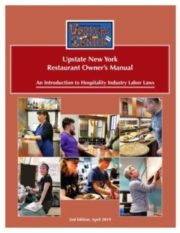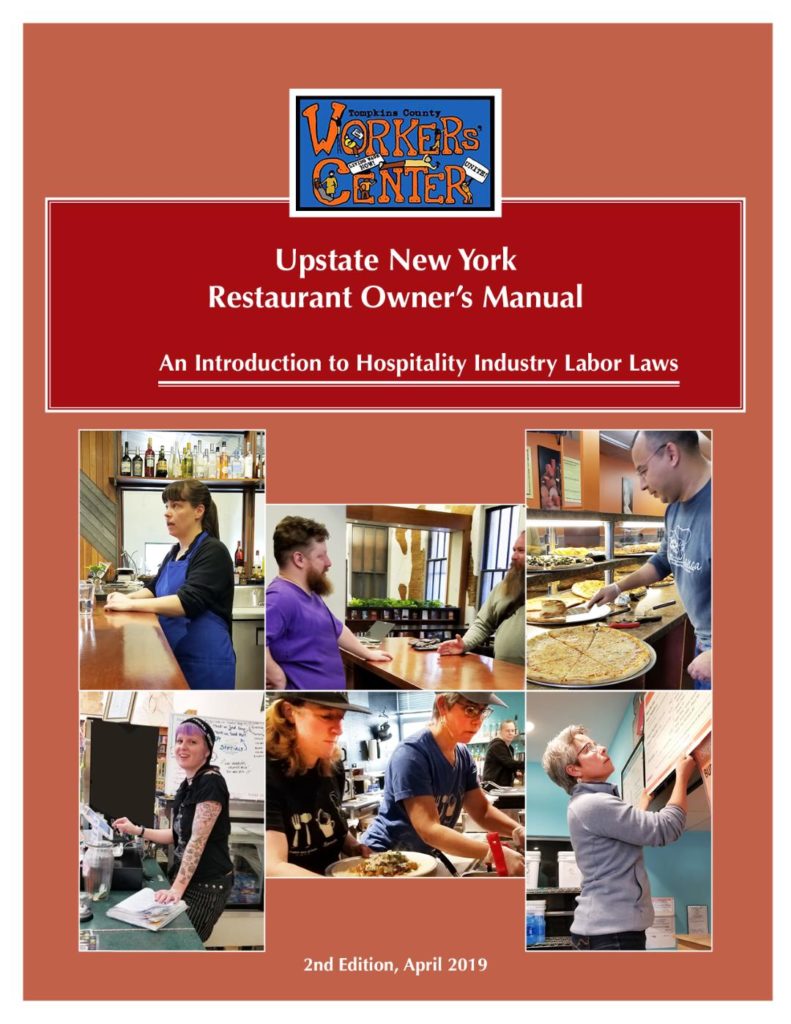Tompkins Workers’ Center Releases 2nd Edition of Restaurant Owners Manual
The 1st edition of the Restaurant Owner’s Manual was created by the Tompkins County Workers’ Center in collaboration with a multitude of community and governmental organizations. The expanded second edition, updated with changes to labor regulation and understanding of best practices in the years since, is a resource for any business owner or manager in the food service industry in Upstate New York. (There are conditions that apply to New York City / Downstate enterprises that we do not cover here.) It is equally a resource for workers in the sector.
Upstate New York Restaurant Owner’s Manual, 2nd Edition: Direct link to PDF
Below we include the Foreward, by Roberta Reardon, New York State Comissioner of Labor, and the Introduction by Ashley Cake, a hospitality industry business owner.
Thanks to our second edition co-editors Liam Audet and Nico Hirschl for their work preparing this resource for you.
FOREWARD
ROBERTA REARDON
Commissioner
W. A. HARRIMAN STATE OFFICE CAMPUS, BUILDING 12, ALBANY, NY 12240U
As New Yorkers, we are privileged to live in a state brimming with
culture. We celebrate our diversity and differences, and restaurants are
an example of how we express our love for our culture and share it with
others. Through the experience of dining together, we strengthen our
bond as a community. Restaurants add vibrant flavor to the places we
live, and are
often the catalyst that encourages
visitors and locals alike to explore and patronize our downtowns. The
New York State Department of Labor and the Tompkins County Workers’
Center deeply value the significant contribution restaurants make to the
economic vitality of the region, and consider restaurants esteemed
cornerstones of the business community.
For
generations, families, friends, neighbors and colleagues have gathered
at their favorite local restaurants to share meals. These establishments
are home to memories made, milestones celebrated and conversations had.
They are keepers of countless smiles, laughs and unforgettable moments.
The proprietors and staff are far more to their patrons than simply
those serving food and performing a service; for many, they feel like
family.
Operating a restaurant comes
with tremendous responsibility. As a restaurant owner, it is your duty
to protect those who work for you. It is a privilege to employ treasured
neighbors and friends, and place your trust in them to act as
ambassadors for your business, your passion and your culture. As times
evolve, so do workplace standards. It is imperative that
you
remain vigilant in knowing the law. The prosperity of your business and
workforce depend on your keen understanding of and commitment to
compliance. Paying your staff the mandated wage, ensuring they are paid
the wages they are owed, and maintaining a safe work environment free
from occupational hazards, discrimination, and harassment make the
tangible promise that you value them and take pride in your business. By
complying with state and federal laws, you set a positive example
within your community, and become the gold standard for doing business.
The
New York State Department of Labor is your ally. The success of your
business is our priority. We commend your investment in your community,
and reaffirm our investment in you. This manual is a phenomenal
resource, and we extend our gratitude to the Tompkins County Workers’
Center for their tireless work toward ensuring a safe and dignified
workplace for all.
Sincerely,
Roberta Reardon
[The information in this manual comes from several sources and
provides this information as a public service. The Department of Labor
makes no guarantees, warranties, or assurances of any kind, express or
implied, with respect to such information, including any information on
linked sites and including, but not limited to, accuracy of the
information or its completeness, timeliness, usefulness, adequacy,
continued availability, or ownership. Employers should seek the opinion
of counsel to ensure they are meeting all of their responsibilities
under state and federal law.]
Upstate New York Restaurant Owners Manual Intro
Ashley D. C. Cake
President and CEO, The Watershed (GDAM Industries, Inc.)
Growing
up in Ithaca, from my first job as a cashier at the Hancock St. P&C
in 1994 to owning the Watershed today, working in food service and
hospitality has not only put me in touch with the growing market of
affluent consumers, but also allowed me to develop complex relationships
of solidarity with my fellow workers. As the cost of living increases
amidst stagnating wages, the service of luxury commodities exacerbates a
two tier system with laborers below the line supporting the consumers
up top. Bartending at high end establishments, my job is in large part
to “make it look easy.†Good service means obscuring the supply chain as
well as my own and others’ labor in making luxury commodities available
to our predominantly wealthy clientele, all without their having to
think about where it’s all coming from and at what cost. I joke
sometimes that bartenders and servers wear black because like stage
hands we are not to be seen, our interests are not the priority in the
show of service. This is the over-arching reality that motivated us at
the Watershed to certify ourselves as a living wage employer,
guaranteeing our bartenders at least $16 an hour regardless of service
volume.
A 2017 economic analysis put
together by Tompkins County Area Development reveals that around 8% of
Tompkins County’s jobs are in accommodation and food service, with
average annual earnings of around $21,000 per year, far below the
$31,000 annual living wage without health benefits set by the
Alternatives Federal Credit Union Living Wage Study released in 2017.
Ithaca itself is one of the metro areas with the highest income
inequality in the nation. In 2016 Mayor Svante Myrick brought home the
salient point that while Ithaca itself is a booming economy that has
enjoyed a 37% growth in average wealth, there has only been a 15%
increase in median wealth. The rising tide of prosperity is not lifting
those boats with holes in them.
The
reality is that many hospitality workers are just scraping by in
Tompkins County. Many have to choose between unaffordable housing in the
City of Ithaca, and shifting unaffordability to their transportation
costs and the expense of owning and maintaining a car amidst the
congested traffic and scarce parking in the rapidly developing Central
Business District. Single parents working in the service industry have
to weather all of these challenges while affording childcare at hours
when schools and subsidized child care programs are not typically
available and single parent families suffer disproportionately from the
seasonal, irregular scheduling that is endemic to the service and
hospitality industries.
The regulations
and guidelines contained in this manual are an important rubric for
strengthening the position of hospitality workers, particularly those
making near the minimum wage. Given the high cost of doing business in
Ithaca, many business owners are inclined to cut and suppress their
labor costs before other measures, and workers are left with growing job
insecurity and are increasingly vulnerable to wage theft and
exploitation. That inequity is not only economically unsustainable but
morally unconscionable. In order to address this problem and sustain the
economic growth in Tompkins County, business owners must be held
accountable for compensating and protecting their workers according to
county, state, and federal law, and the interests of labor must be
prioritized, advocated for, and ultimately elevated.
This
manual, as well as the excellent work done by the Tompkins County
Workers Center, is an important step in that direction. As a career
service worker and now an employer, the Workers Center has given me
ample resources and support to do the best I can for my employees, and I
hope that many other businesses in Tompkins County take up these
resources and work in solidarity with their employees to foster a more
equitable economy and a mutually sustainable future for our shared
communities.


